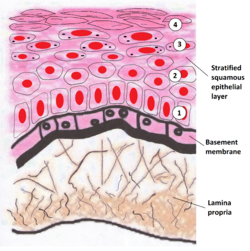Lamina propria
| Lamina propria | |
|---|---|
 | |
| Details | |
| Part of | Mucosa |
| Identifiers | |
| Latin | lamina propria mucosæ |
| FMA | 62517 |
| Anatomical terminology | |
The lamina propria is a thin layer of
The lamina propria is a thin layer of
The connective tissue of the lamina propria is loose and rich in cells. The cells of the lamina propria are variable and can include
Structure
The lamina propria is a loose connective tissue, hence it is not as fibrous as the underlying connective tissue of the submucosa.[4][self-published source?] The connective tissue and architecture of the lamina propria is very compressible and elastic, this can be seen in organs that require expansion such as the bladder.[5] The collagen in the lamina propria of elastic organs has been shown to play a major role in mechanical function. In the bladder the collagen composition of its lamina propria allows for structure, tensile strength, and compliance, through complex coiling.[6] It has been suggested that myofibroblasts also reside in the lamina propria of several organs. These cells have characteristics of both smooth muscle and fibroblasts.[7]
The lamina propria may also be rich in vascular networks, lymphatic vessels, elastic fibers, and smooth muscle fascicles from the muscularis mucosae. Afferent and efferent nerve endings can be found in the lamina propria as well.[6] Immune cells as well as lymphoid tissue, including lymphoid nodules and capillaries, may be present. Smooth muscle fibers may be in the lamina propria, such as in the intestinal villi. It is practically void of fat cells.[4] Lymphatics penetrate the mucosa and lie below the basement membrane of the epithelium, from there they drain the lamina propria.[8] The fast rate of cell death and regeneration of the epithelium leaves behind many apoptotic cell bodies. These have been found to go into the lamina propria, most of which are inside its macrophages.[9]
Function
Role in the immune system
Because the epithelium is often under external stress and is somewhat delicate, the lamina propria hosts many immune cells.[4] In the intestinal tract the immune system must have tolerance to the normal intestinal flora, yet respond to pathogenic microorganisms. Imbalance of this causes inflammation diseases such as inflammatory bowel disease.[10] The lamina propria’s richness in macrophages and lymphoid cells makes it a key place for immune responses to occur. It forms part of the barrier that protects internal tissues from external pathogenic microorganisms, especially from the gastrointestinal tract.[11]
Clinical significance
Progression of epithelial
Long-standing inflammation is a risk factor for the development of cancer. The lamina propria macrophages when under much stress release pro-inflammatory signals that may lead to increased probability of developing cancer. An example of this is the over activation of the IL-6/STAT3 pathway, which has been linked to colitis-associated cancer.[14]
See also
- Basal lamina (part of which is also known as lamina densa)
- Myofibroblast
- Submucosa
References
- ISBN 978-0-443-04691-9.[page needed]
- ^ Slomianka, Lutz (2009). "Blue Histology-Gastrointestinal Tract". The University of Western Australia.
- ISBN 978-0-07-171475-4.[page needed]
- ^ a b c King, David (2009). "Study Guide: Histology of the Gastrointestinal System".
- PMID 10573775.
- ^ PMID 23847015.
- S2CID 7628206.
- ^ PMID 9527214.
- PMID 7706406.
- PMID 19733097.
- PMID 25407511.
- PMID 22670190.
- PMID 16938525.
- PMID 20042582.
External links
- Anatomy Atlases – Microscopic Anatomy, plate 10.198
- Histology image: 10802loa – Histology Learning System at Boston University - "Digestive System: Alimentary Canal - esophagus "
- Histology image: 03301loa – Histology Learning System at Boston University - "Connective Tissue: lamina propria; loose connective tissue "
- UIUC Histology Subject 272
- Anatomy photo: Digestive/mammal/system1/system3 - Comparative Organology at University of California, Davis - "Mammal, whole system (LM, Low)"
- Slide at ucla.edu
